Abstract
The interactions of dipyridamole with α1 acid glycoprotein of plasma and with human platelets are related to inhibition of adenosine uptake by platelets. Binding studies by equilibrium gel filtration suggested that 1 mol of dipyridamole binds per mol of α1 acid glycoprotein with a dissociation constant of 1.6 μM. Platelets contain two populations of binding sites, one with high and another with lower affinity for the drug. The binding of dipyridamole to the high-affinity sites follows a Michaelis-Menten binding pattern with a dissociation constant of 0.04 μM. Approximately 2 × 104 dipyridamole molecules are bound at the high-affinity sites of each platelet. The lower affinity sites bind the drug with a dissociation constant of 4 μM. In the presence of α1 acid glycoprotein of plasma, the binding of dipyridamole to human platelets is inhibited. Correspondingly, the dipyridamole inhibition of adenosine uptake by platelets is reduced 1,000-fold by purified α1 acid glycoprotein. The binding of dipyridamole to human platelets was found to be essential for its inhibition of adenosine uptake by platelets. Dipyridamole decreases the incorporation of [14C]adenosine radioactivity in platelet nucleotides and reduces the [14C]-ATP to [14C]ADP ratio. Purified α1 acid glycoprotein reverses these effects of dipyridamole on adenosine metabolism of platelets in a concentration-dependent manner. An equilibrium of dipyridamole binding to α1 acid glycoprotein and to platelets is proposed.
Full text
PDF
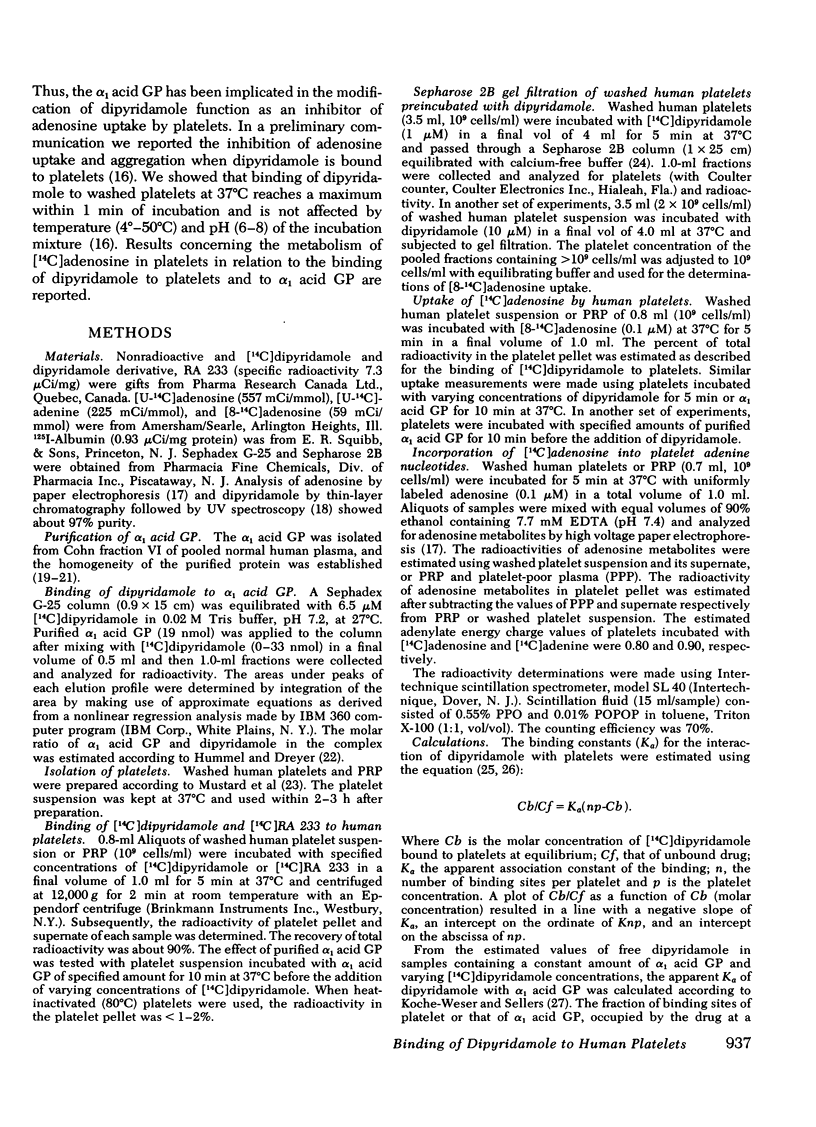
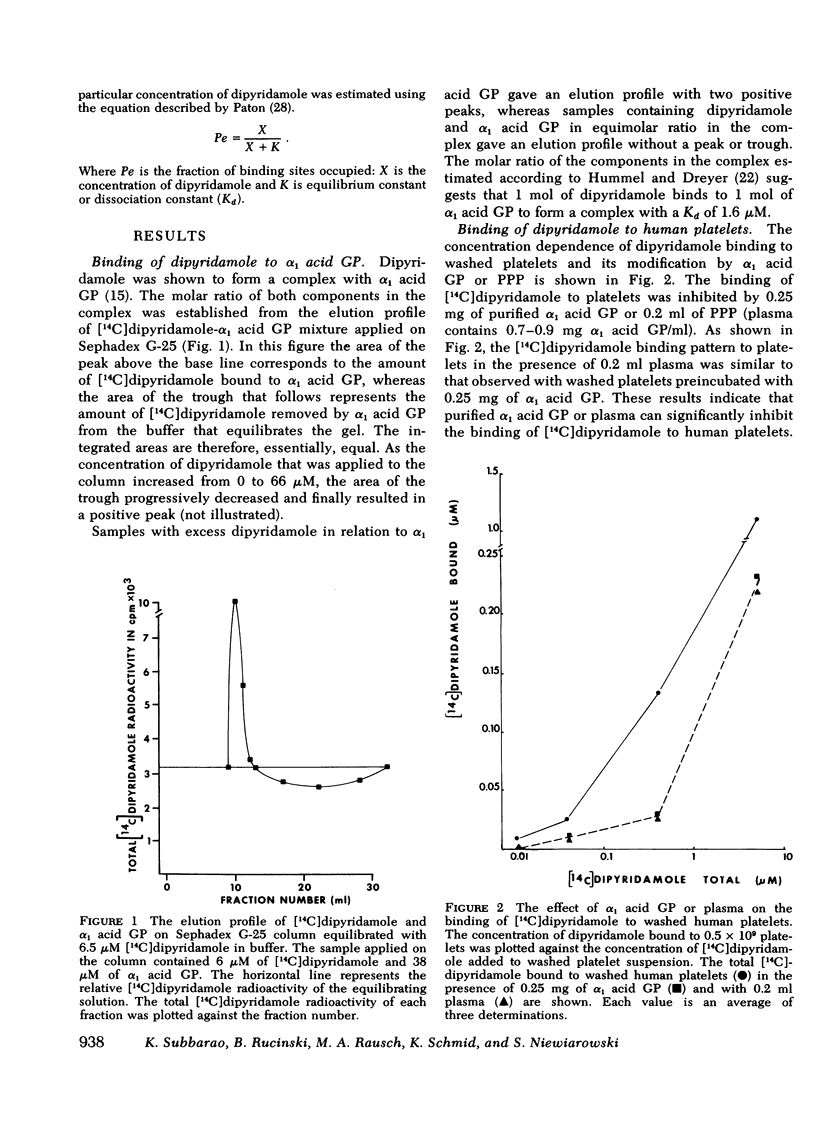
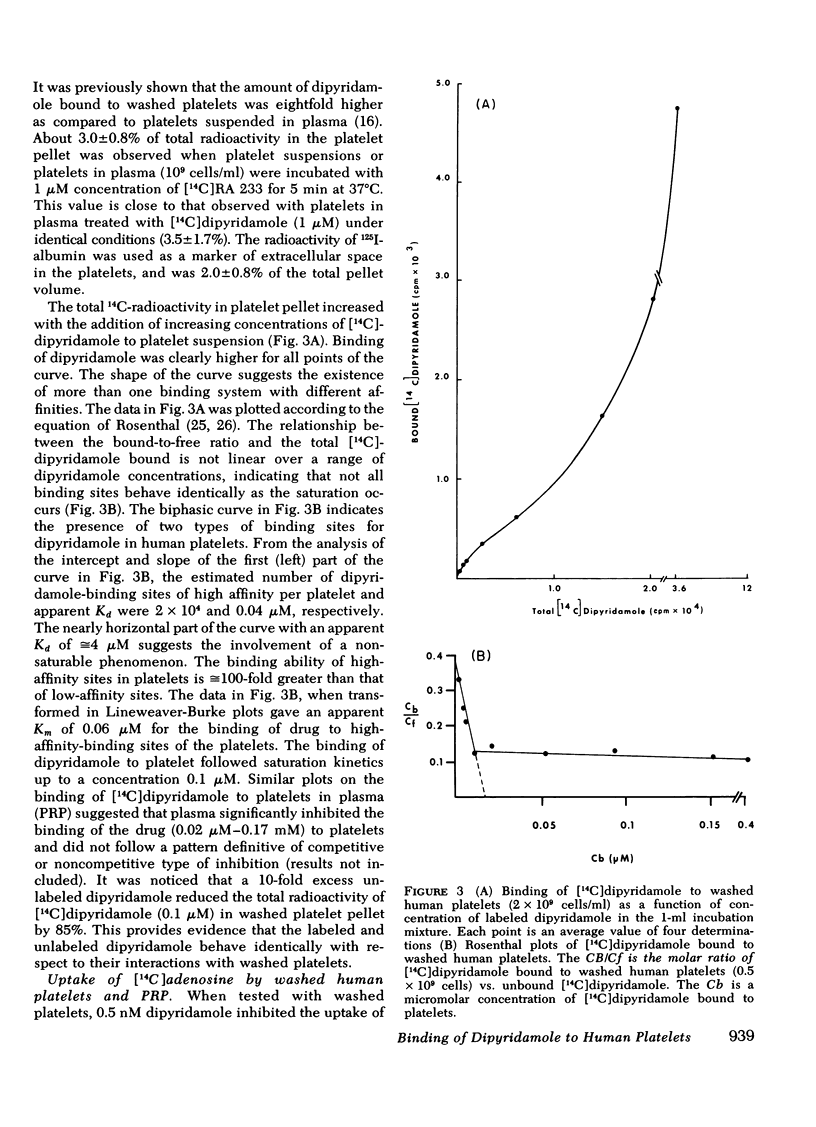
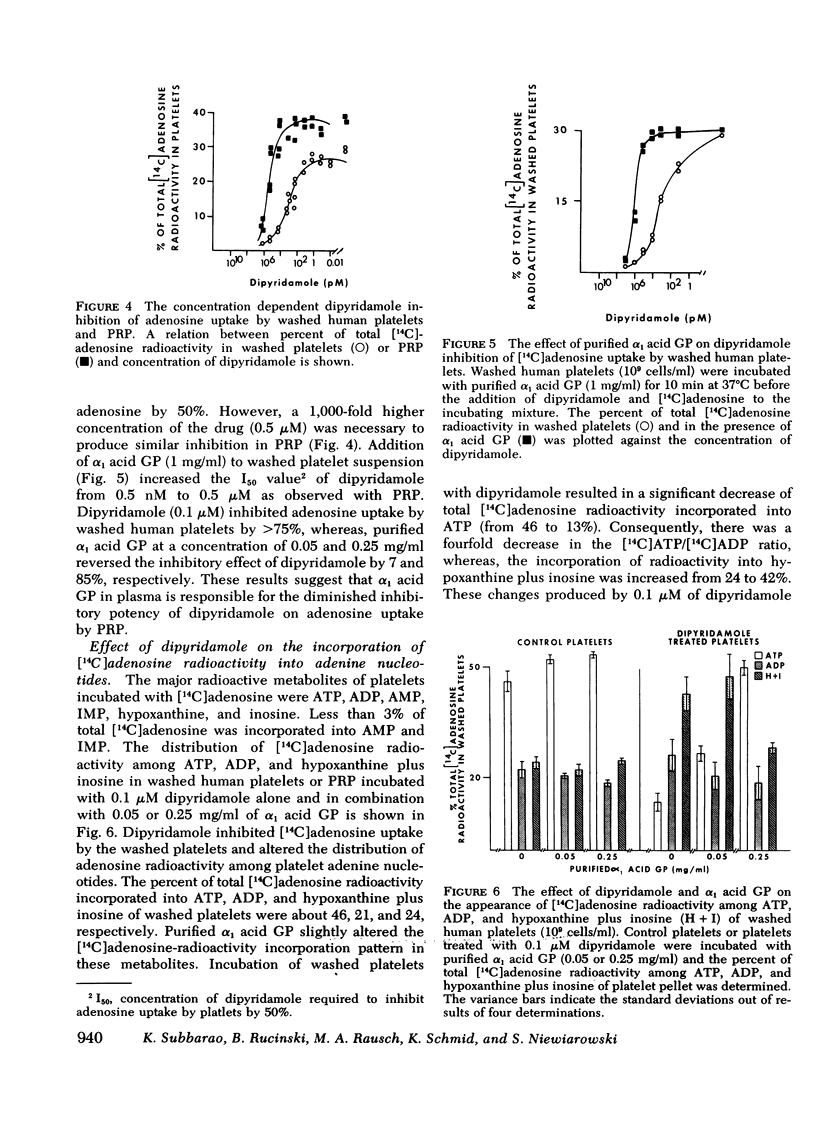
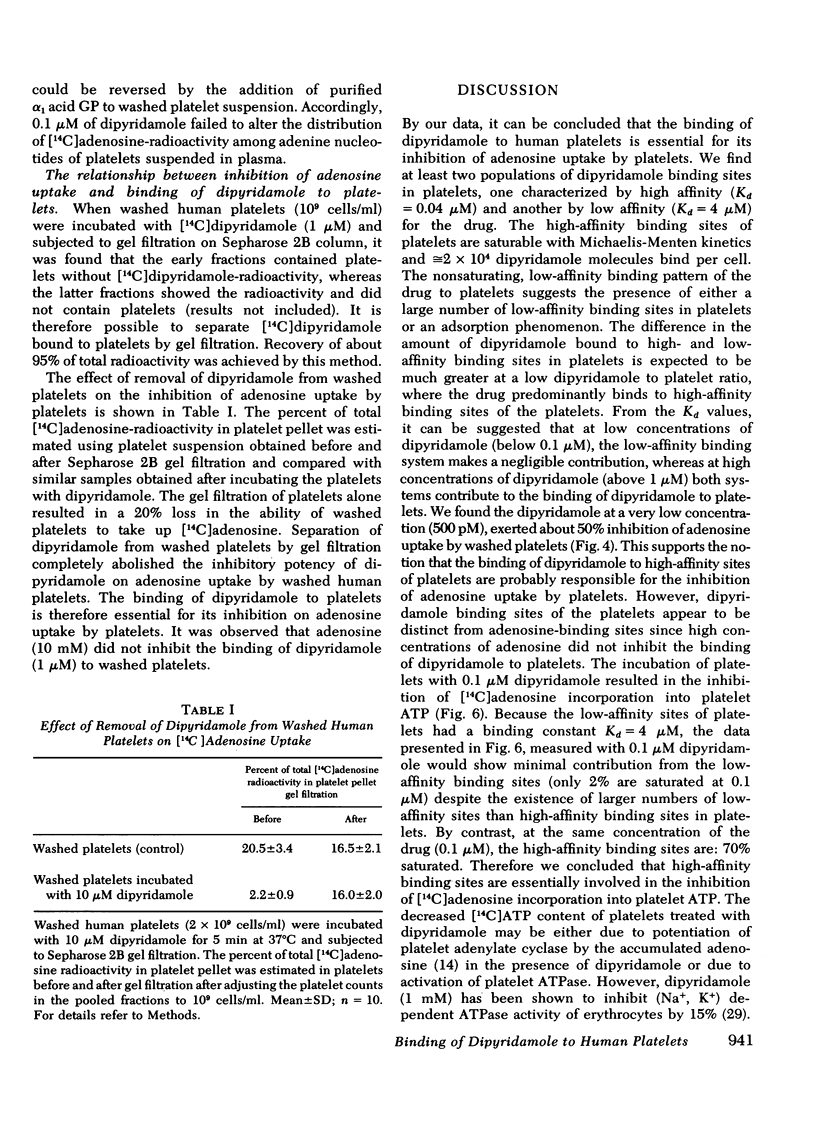
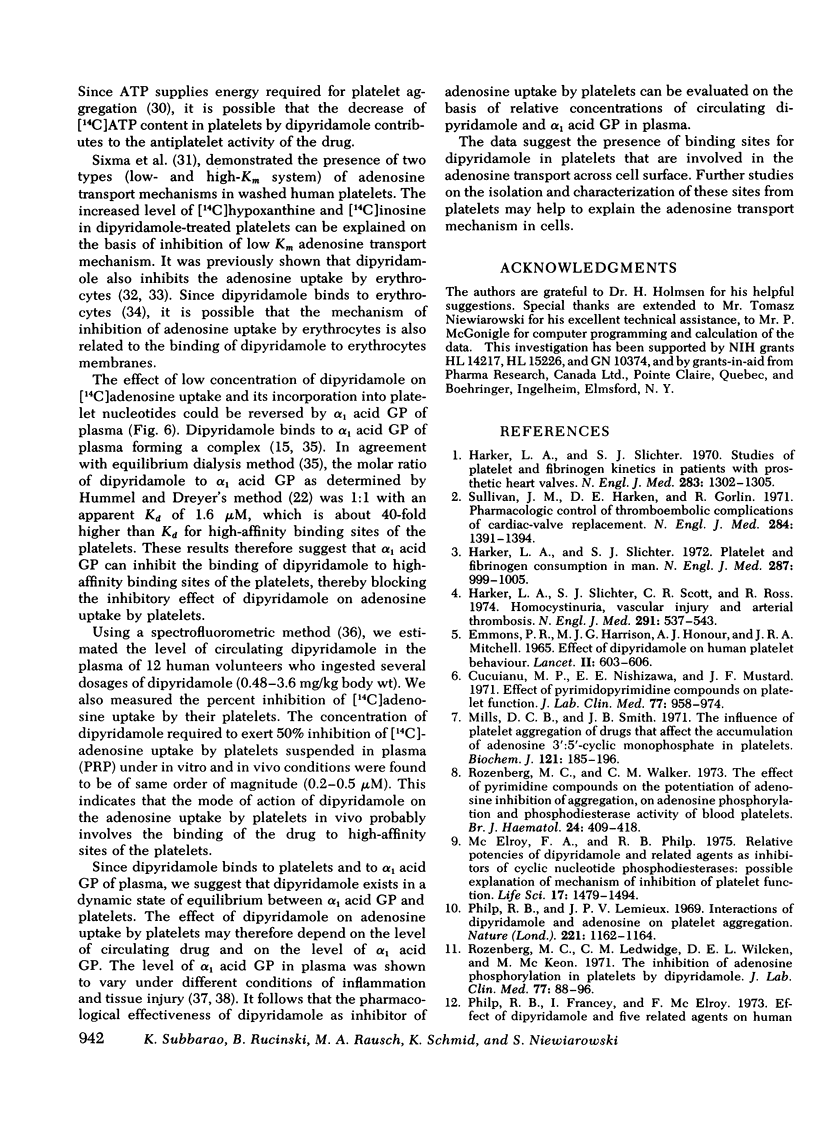
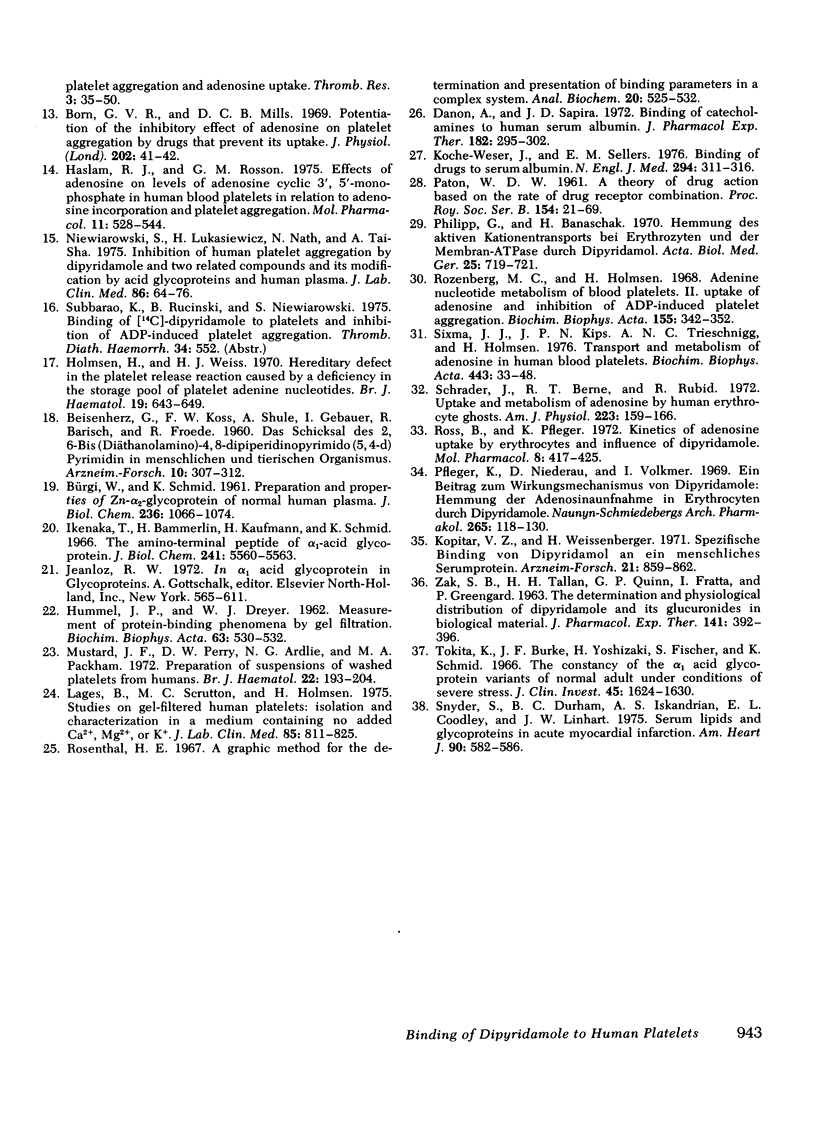
Selected References
These references are in PubMed. This may not be the complete list of references from this article.
- BEISENHERZ G., KOSS F. W., SCHUELE A., GEBAUER I., BAERISCH R., FROEDE R. [The fate of 2,6-bis(diethanolamino)-4,8-dipiperidinopyrimido-(5,4-d)-pyrimidine in the human and animal organism]. Arzneimittelforschung. 1960 Apr;10:307–312. [PubMed] [Google Scholar]
- BURGI W., SCHMID K. Preparation and properties of Zn-alpha 2-glycoprotein of normal human plasma. J Biol Chem. 1961 Apr;236:1066–1074. [PubMed] [Google Scholar]
- Cucuianu M. P., Nishizawa E. E., Mustard J. F. Effect of pyrimido-pyrimidine compounds on platelet function. J Lab Clin Med. 1971 Jun;77(6):958–974. [PubMed] [Google Scholar]
- Danon A., Sapira J. D. Binding of catecholamines to human serum albumin. J Pharmacol Exp Ther. 1972 Aug;182(2):295–302. [PubMed] [Google Scholar]
- Emmons P. R., Harrison M. J., Honour A. J., Mitchell J. R. Effect of dipyridamole on human platelet behaviour. Lancet. 1965 Sep 25;2(7413):603–606. doi: 10.1016/s0140-6736(65)90515-5. [DOI] [PubMed] [Google Scholar]
- HUMMEL J. P., DREYER W. J. Measurement of protein-binding phenomena by gel filtration. Biochim Biophys Acta. 1962 Oct 8;63:530–532. doi: 10.1016/0006-3002(62)90124-5. [DOI] [PubMed] [Google Scholar]
- Harker L. A., Slichter S. J. Platelet and fibrinogen consumption in man. N Engl J Med. 1972 Nov 16;287(20):999–1005. doi: 10.1056/NEJM197211162872001. [DOI] [PubMed] [Google Scholar]
- Harker L. A., Slichter S. J., Scott C. R., Ross R. Homocystinemia. Vascular injury and arterial thrombosis. N Engl J Med. 1974 Sep 12;291(11):537–543. doi: 10.1056/NEJM197409122911101. [DOI] [PubMed] [Google Scholar]
- Harker L. A., Slichter S. J. Studies of platelet and fibrinogen kinetics in patients with prosthetic heart valves. N Engl J Med. 1970 Dec 10;283(24):1302–1305. doi: 10.1056/NEJM197012102832402. [DOI] [PubMed] [Google Scholar]
- Haslam R. J., Rosson G. M. Effects of adenosine on levels of adenosine cyclic 3',5'-monophosphate in human blood platelets in relation to adenosine incorporation and platelet aggregation. Mol Pharmacol. 1975 Sep;11(5):528–544. [PubMed] [Google Scholar]
- Holmsen H., Weiss H. J. Hereditary defect in the platelet release reaction caused by a deficiency in the storage pool of platelet adenine nucleotides. Br J Haematol. 1970 Nov;19(5):643–649. doi: 10.1111/j.1365-2141.1970.tb01648.x. [DOI] [PubMed] [Google Scholar]
- Ikenaka T., Bammerlin H., Kaufmann H., Schmid K. The amino-terminal peptide of alpha-1-acid glycoprotein. J Biol Chem. 1966 Dec 10;241(23):5560–5563. [PubMed] [Google Scholar]
- Koch-Weser J., Sellers E. M. Binding of drugs to serum albumin (first of two parts). N Engl J Med. 1976 Feb 5;294(6):311–316. doi: 10.1056/NEJM197602052940605. [DOI] [PubMed] [Google Scholar]
- Kopitar Z., Weisenberger H. Spezifische Bindung von Dipyridamol an ein menschliches Serumprotein. Seine Isolierung, Identifizierung und Charakterisierung als alpha-1-saures Glycoprotein. Arzneimittelforschung. 1971 Jun;21(6):859–862. [PubMed] [Google Scholar]
- Lages B., Scrutton M. C., Holmsen H. Studies on gel-filtered human platelets: isolation and characterization in a medium containing no added Ca2+, Mg2+, or K+. J Lab Clin Med. 1975 May;85(5):811–825. [PubMed] [Google Scholar]
- Mills D. C., Smith J. B. The influence on platelet aggregation of drugs that affect the accumulation of adenosine 3':5'-cyclic monophosphate in platelets. Biochem J. 1971 Jan;121(2):185–196. doi: 10.1042/bj1210185. [DOI] [PMC free article] [PubMed] [Google Scholar]
- Mustard J. F., Perry D. W., Ardlie N. G., Packham M. A. Preparation of suspensions of washed platelets from humans. Br J Haematol. 1972 Feb;22(2):193–204. doi: 10.1111/j.1365-2141.1972.tb08800.x. [DOI] [PubMed] [Google Scholar]
- Niewiarowski S., Lukasiewicz H., Nath N., Tai Sha A. Inihibition of human platelet aggregation by dipyridamole and two related compounds and its modification by acid glycoproteins of human plasma. J Lab Clin Med. 1975 Jul;86(1):64–76. [PubMed] [Google Scholar]
- Pfleger K., Niederau D., Volkmer I. Ein Beitrag zum Wirkungsmechanismus von Dipyridamol: Hemmung der Adenosinaufnahme in Erythrocyten durch Dipyridamol. Naunyn Schmiedebergs Arch Pharmakol. 1969;265(2):118–130. [PubMed] [Google Scholar]
- Philipp G., Banaschak H. Hemmung des aktiven Kationentransports bei Erythrozyten und der Membran-ATPase durch Dipyridamol. Acta Biol Med Ger. 1970;25(4):719–721. [PubMed] [Google Scholar]
- Philp R. B., Lemieux J. P. Interactions of dipyridamole and adenosine on platelet aggregation. Nature. 1969 Mar 22;221(5186):1162–1164. doi: 10.1038/2211162a0. [DOI] [PubMed] [Google Scholar]
- Roos H., Pfleger K. Kinetics of adenosine uptake by erythrocytes, and the influence of dipyridamole. Mol Pharmacol. 1972 Jul;8(4):417–425. [PubMed] [Google Scholar]
- Rosenthal H. E. A graphic method for the determination and presentation of binding parameters in a complex system. Anal Biochem. 1967 Sep;20(3):525–532. doi: 10.1016/0003-2697(67)90297-7. [DOI] [PubMed] [Google Scholar]
- Rozenberg M. C., Holmsen H. Adenine nucleotide metabolism of blood platelets. II. Uptake of adenosine and inhibition of ADP-induced platelet aggregation. Biochim Biophys Acta. 1968 Feb 26;155(2):342–352. [PubMed] [Google Scholar]
- Rozenberg M. C., Ledwidge C. M., Wilcken D. E., McKeon M. The inhibition of adenosine phosphorylation in platelets by dipyridamole. J Lab Clin Med. 1971 Jan;77(1):88–96. [PubMed] [Google Scholar]
- Rozenberg M. C., Walker C. M. The effect of pyrimidine compounds on the potentiation of adenosine inhibition of aggregation, on adenosine phosphorylation and phosphodiesterase activity of blood platelets. Br J Haematol. 1973 Apr;24(4):409–418. doi: 10.1111/j.1365-2141.1973.tb01667.x. [DOI] [PubMed] [Google Scholar]
- Schrader J., Berne R. M., Rubio R. Uptake and metabolism of adenosine by human erythrocyte ghosts. Am J Physiol. 1972 Jul;223(1):159–166. doi: 10.1152/ajplegacy.1972.223.1.159. [DOI] [PubMed] [Google Scholar]
- Sixma J. J., Lips J. P., Trieschnigg A. M., Holmsen H. Transport and metabolism of adenosine in human blood platelets. Biochim Biophys Acta. 1976 Aug 4;443(1):33–48. doi: 10.1016/0005-2736(76)90489-2. [DOI] [PubMed] [Google Scholar]
- Snyder S., Durham B. C., Iskandrian A. S., Coodley E. L., Linhart J. W. Serum lipids and glycoproteins in acute myocardial infarction. Am Heart J. 1975 Nov;90(5):582–586. doi: 10.1016/0002-8703(75)90221-5. [DOI] [PubMed] [Google Scholar]
- Subbarao K., Rucinski B., Niewarowski S. Proceedings: Binding of (14C) dipyradamole (RA 8) to platelets and inhibition of ADP induced platelet aggregation. Thromb Diath Haemorrh. 1975 Nov 15;34(2):552–553. [PubMed] [Google Scholar]
- Sullivan J. M., Harken D. E., Gorlin R. Pharmacologic control of thromboembolic complications of cardiac-valve replacement. N Engl J Med. 1971 Jun 24;284(25):1391–1394. doi: 10.1056/NEJM197106242842501. [DOI] [PubMed] [Google Scholar]
- Tokita K., Burke J. F., Yoshizaki H., Fischer S., Schmid K. The constancy of the alpha-1-acid glycoprotein variants of normal adults under conditions of severe stress. J Clin Invest. 1966 Oct;45(10):1624–1630. doi: 10.1172/JCI105469. [DOI] [PMC free article] [PubMed] [Google Scholar]
- ZAK S. B., TALLAN H. H., QUINN G. P., FRATTA I., GREENGARD P. THE DETERMINATION AND PHYSIOLOGICAL DISTRIBUTION OF DIPYRIDAMOLE AND ITS GLUCURONIDES IN BIOLOGICAL MATERIAL. J Pharmacol Exp Ther. 1963 Sep;141:392–398. [PubMed] [Google Scholar]


